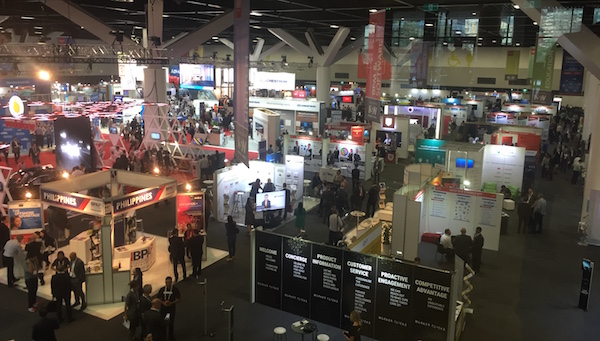women in technology at the CeBIT Technology and Business Summit

Walking into the CeBIT Conference is not unlike being ushered into some revolutionary space-age marketplace, where suit-and-lanyard-clad businessmen smile knowingly at you from behind a thousand different shimmering screens: laptops, iPads and feature walls with PowerPoints projected across them. CeBIT is APAC’s largest and longest running technology exhibition and conference, and it is an essential peephole into the future of business technologies. It’s also, tragically and unsurprisingly, a total sausage fest.
In covering the events at CeBIT, it’s difficult to translate the effervescent energy in the conference centre to the page. Despite the fact that each booth was hocking moderately mundane innovations (improved multi-call systems for office landlines, USB plug-ins that cater for a sensoration in Variable Bitrate for webOS 2.0S), the atmosphere within the exhibition hall was one of candid excitement; little boys and their brand new toys.
The one particular event that I was drawn to, especially considering the state of the conference, was the Women in Technology panel. So there are some ladies here! I made my way to the Pyrmont Theatre at 12.00pm with a very (very) overpriced latte in one hand and my twitter account open in the other, honestly glad to be out of the throng of wireless this and two-point-oh that.
The panel itself, I have to say, was actually incredibly interesting, and each and every member of it was individually inspiring. The panel itself focused on how STEM subjects, and the Information Technology fields in particular, could welcome more women into their ranks. The only real shame was how many people were interested enough to attend and listen.
The theatre itself was one-fifth full, if that, despite the fact that the previous panel discussing CEO positions and leading high-performance teams. But I’ll move past my indignation for that one, because frankly I wasn’t hoping for much more.
The members of the panel were Jo Burston (CEO and Founder, Inspiring Rare Birds and Job Capital), Julie Canepa (Head of IT Australia And New Zealand, Cisco), Julia Dickinson (General Manager, Satellite Engineering, NBN Australia), Dr Chrissy Burns (Chief Information Officer, University of Technology Sydney), Anastasia Cammaroto (Chief Information Officer, Consumer Bank, Westpac) and Sandra Coleman (GM Strategy, Transformation and Technology, Rest Industry Super). The panel had collectively over one hundred and twenty years of experience in Information Technology – which was a fantastic observation to make.
The discussion circled mostly around the tension that employers and educators face between stopping the ever-present drop-out rate of female students and employees in STEM fields, versus the resources and manipulation of stereotypes needed to encourage women to engage in STEM subjects in the first place.
Notable quotes included Jo Burston’s observation that “you cannot be what you cannot see”, and her heartfelt encouragement to make women in technology more visible so that young girls not only have heroines to look up to, but also mentors to help them along their journey. Anastasia Cammaroto was a remarkable member of the panel in my opinion, as she seemed to be able to directly point out the important distinction between opportunities for young girls to learn about IT, versus the stereotypes that exist to quash these opportunities. She was a particularly insightful speaker.
Topaz Conway from Start Up Australia, who was moderating the discussion, made many insightful points throughout the discussion. However, unfortunately, there was one moment that disappointed me when she was discussing the experiences of her three daughters. Citing the barriers that exist for women entering IT careers, Conway was clearly very knowledgeable about the plights that women face in STEM fields. However, after explaining that one of her daughters had faced one too many obstacles, she said the following:
“My daughter then became a teacher. Which is a shame you know, because she had so much more potential.”
I appeared to be the only member of the audience that was shocked by this statement. Of course I am definitely behind any movement to promote maths and sciences for women, however do we need to disparage any other workforce to do it by making a value judgement on its worth? It was disappointing to hear that there is still very much an intellectual hierarchy that exists in Information careers, despite the fact that it’s obvious that they are haemorrhaging employees, especially in Australia and the general West.
Overall, my experience at the CeBIT Summit was illuminating, though not necessarily in the areas that I expected. I walked away none the wiser about when to expect Google Glass to hit the shelves, or when I’ll be able to play Candy Crush in fully immersive Virtual Reality mode. I did, however, walk away with a nagging tension; two duelling realisations. Firstly, that technology-based businesses are dangerously lacking in female perspectives. And secondly that there are some incredible women out there who are fighting to make changes in their workplaces. To make coding and mathematics ‘cool’ again. And that was an uplifting thought, because when I step into that revolutionary space-age marketplace again next year, I’d love to see at least one knowing smile from a woman behind a shimmering screen for once. Even if she, too, tries to talk to me about the optimisation of sitemaps in relation to user flow in the cloud.

